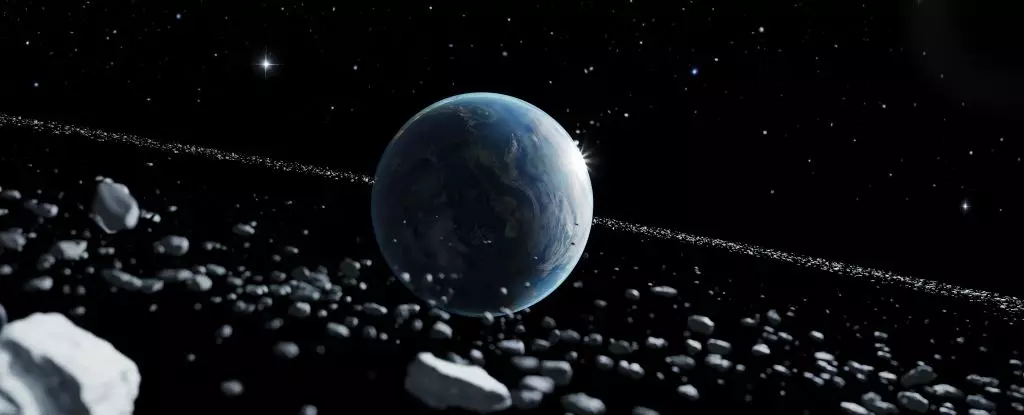In the vast tapestry of our Solar System, it’s easy to overlook the remarkable evolutionary stories told by planets. Among these narratives lies a fascinating hypothesis regarding Earth: that it may have once possessed a ring system reminiscent of those orbiting gas giants like Saturn. This enigma, initially proposed by planetary scientist Andy Tomkins and his team at Monash University, suggests that Earth’s geological history might be marked by a unique period where a ring composed of asteroid debris peppered our planet’s surface with meteorite impacts. Despite the fleeting existence of such a ring—perhaps lasting no more than tens of millions of years—its consequences may extend far beyond its brief celestial appearance, challenging our understanding of Earth’s geological and climatic evolution.
One of the most compelling pieces of evidence supporting the ring hypothesis comes from an event known as the Ordovician impact spike. Occurring approximately 466 million years ago, this notable geological occurrence saw an uptick in meteorite impacts over a short period, lasting around 40 million years. Detailed geological analysis reveals patterns in these impacts: 21 craters formed within a strikingly narrow latitude band near the equator. This spatial clustering of impacts raises intriguing questions—what could possibly have caused such a concentrated bombardment of a planet that was primarily partaking in the evolutionary drama of a supercontinent, Gondwana?
Tomkins and his team delve deeper into this mystery, suggesting that the impacts themselves suggest a more complicated backdrop. They theorize that if a ring of debris had encircled Earth, it could explain both the clustering of the craters and the meteorite debris discovered in sedimentary layers dated to this epoch. This interstellar scenario portrays a narrative where celestial objects are not merely external stimuli, but rather integral players in shaping life on Earth.
The Mechanics of a Cosmic Ring
The scientific inquiry extends to the mechanics of celestial forces that could give rise to a planetary ring. According to Tomkins, an asteroid could have wandered into Earth’s sphere of influence and, instead of crashing directly into our planet, was torn apart by gravitational tidal forces when it crossed the Roche limit. This boundary, approximately 15,800 kilometers above Earth’s surface, can serve as a celestial dividing line. Within this zone, loosely bound materials are susceptible to disintegration, leading to a shower of cosmic remnants that would have formed an orbital ring around Earth.
While rings are often associated with gas giants, the idea seems plausible when one considers historical observations of planetary bodies, such as the infamous comet Shoemaker-Levy 9, which met its dramatic end after being shredded by Jupiter’s gravity. A parallel scenario for Earth might illuminate an unexpected chapter in its geological history while simultaneously reframing our understanding of planetary dynamics.
Delving deeper into this hypothesis exposes an even broader implications involving Earth’s climate. Tomkins posits that the presence of a ring could have led to climatic shifts by casting significant shadows over the Earth’s surface. If this were indeed the case, then the cooling effect of such a ring would warrant further examination, particularly considering that the late Ordovician marks a period that experienced a dramatic ice age.
By examining the interplay between meteorite impacts and climatic conditions during this era, one could explore how these factors contributed to significant biological events, namely the Great Ordovician Biodiversification Event. The rapid pace of evolution during this time might not simply be attributed to environmental stresses, but possibly also to a regime of cooling instigated by the ring’s shadowy presence, promoting new adaptations among organisms struggling to survive in dynamic conditions.
While Tomkins and his team have laid the foundational groundwork for a captivating hypothesis, the quest for evidence doesn’t stop here. The next phase involves leveraging numerical modeling to simulate the fragmentation of the asteroid and the formation and evolution of the hypothesized ring. Such computer models could yield insights into the ring’s size, shape, and potential climatic influences, illuminating the complex relationship between celestial phenomena and terrestrial evolution.
The speculative nature of the ring hypothesis is not without risks, and it raises questions about how we interpret geological records through the lens of astronomical events. However, imagination and scientific inquiry go hand in hand; as we ponder the implications of this concept for past geological events, we can also imagine how similar scenarios could inform future planetary sculpting, such as in efforts to terraform inhospitable worlds like Venus.
Conclusion: A Cosmic Play of Forces
The notion that Earth once had a ring is not only a whimsical thought experiment but also a potent reminder of the interconnectedness of cosmic forces and geological processes. It invites us to reconsider the complexity of Earth’s history as a narrative shaped by celestial intrigues that could influence the trajectory of life itself. Though we may never find physical evidence of such a ring, the idea enriches our understanding of Earth’s past and invites further exploration of our planet’s geological story, illuminating the mysterious tapestry of existence that continues to unravel before us.


Leave a Reply